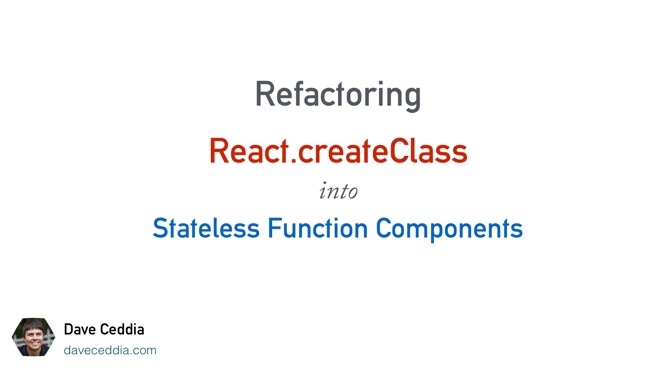As of React 15.5, createClass is deprecated. You’ll get warnings in the console if you’re using it in your code – and, when React 16 comes out, createClass will be removed entirely.
What to do? Well, update your code, of course!
This video and article go over how to convert to stateless function components. You also might want to know how to convert to ES6 classes and I’ve got a video and article for that as well.
Replace createClass
When replacing React.createClass there are 2 options:
- use an ES6 class (learn how here)
- use a stateless function
Here’s how to decide:
- Use an ES6 class if either:
- the component uses state (search for “this.state” to make sure)
- the component uses lifecycle methods like
componentDidUpdate,componentDidMount, etc. - the component has handler methods (
handleClickand such)
- Use a stateless function if none of the above is true
This post covers converting to stateless functions – another one covers ES6 classes.
Before: createClass
Here’s the old syntax. Everything is a property of an object passed to React.createClass.
import React from 'react';
var NameWithHandle = React.createClass({
propTypes: {
author: React.PropTypes.shape({
name: React.PropTypes.string.isRequired,
handle: React.PropTypes.string.isRequired
}).isRequired
},
render: function() {
var { name, handle } = this.props.author;
return (
<span className="name-with-handle">
<span className="name">{name}</span>
<span className="handle">@{handle}</span>
</span>
);
}
});After: Stateless Function
Here’s the same component, converted to a stateless function. It’s fewer lines of code, too!
import React from 'react';
import PropTypes from 'prop-types';
function NameWithHandle({ author }) {
const { name, handle } = author;
return (
<span className="name-with-handle">
<span className="name">{name}</span>
<span className="handle">@{handle}</span>
</span>
);
}
NameWithHandle.propTypes = {
author: PropTypes.shape({
name: PropTypes.string.isRequired,
handle: PropTypes.string.isRequired
}).isRequired
};What changed?
- Props are passed as an argument: No more
this.props.whatever. The first argument to the function is an object containing the props. The code below uses the ES6 destructuring syntax (the{ author }part) which pulls the named keys out of the object and stores them in variables of the same name. - PropTypes are pulled out: Since the component is a function now, its PropTypes are a property on the function itself – instead of being a property on the object that describes the component.
- PropTypes is its own library: In React 15.5, there is no more
React.PropTypes. Instead, there’s a separate module that must be installed withnpm install prop-types, and can be imported asimport PropTypes from 'prop-types'.
Example Project
I put together an example project with 9 different components, both before and after conversion from React.createClass to stateless functions. You can download it here (no email required).
Learning React can be a struggle — so many libraries and tools!
My advice? Ignore all of them :)
For a step-by-step approach, check out my Pure React workshop.

Learn to think in React
- 90+ screencast lessons
- Full transcripts and closed captions
- All the code from the lessons
- Developer interviews
Dave Ceddia’s Pure React is a work of enormous clarity and depth. Hats off. I'm a React trainer in London and would thoroughly recommend this to all front end devs wanting to upskill or consolidate.

